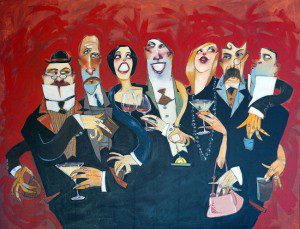In his most recent post at his Wild Fox blog, Zen teacher Dosho Port (truth in advertising, an old and dear friend) brings up the subject of teaching koans. And, with that, of course, studying them. It sparked some comments. After reading them I thought I might have a word or two that could be useful.
Koans, literally “public case” are unique to the Zen way and are anecdotes, bits of poetry, fragments of conversations that Zen teachers find particularly apt in helping students of the way to open their hearts and minds. Or, as Robert Aitken, one of the great masters of koan Zen in the West would say these koans present points in Zen to be made clear.
What is often not understood outside the Zen community is that the use of koans as a teaching tool means different things among us, mainly two different things. A common way of distinguishing between these two approaches is to speak of one as “koan study” and the other as “koan introspection.”
The former is a term for those who admire the literature and who explore a case informally. When a Zen teacher does this the authority for doing so resides within the insights found over many years of practice. Mostly this means through the practice of shikantaza, silent illumination or just sitting, as well as the attendant disciplines of community, retreat and ritual. Most important for this reflection, it doesn’t necessarily mean a Zen teacher is a koan teacher, trained and authorized to do so.
So, teachers within the Soto lineages for the most part, when they take up koans, it is exclusively in this “study” way. And, as I come from the other perspective, I want, really want to underscore how this approach to koans can be enormously enriching. And, also how the stories belong to all of us within the mahasangha. So, go for it!
And.
Koan introspection is a particular discipline with age old protocols to model us toward specific places recognizable by all koan teachers of any lineage. Here we have specific points to explore, many of them, and there are correct and wrong answers, many of them.
Teachers within Rinzai lineages and some Soto lines that have reclaimed the practice, when they take up koans, it is in this “introspection” way.
Dosho spells all this out succinctly.
He then goes on to raise an issue that is important to those of us who’ve given our lives to koan introspection.
Those of us who follow the koan introspection way on occasion get annoyed with teachers, again, completely authentic teachers, but teachers who’ve not undergone the specific discipline, which takes many, many years, who advertise they’re going to teach, or perhaps more modestly, going to explore a koan or a collection of koans.
We sometimes feel there is a muddying of the waters, and when we’re particularly annoyed, a trivializing of a discipline we’ve given our entire lives to.
Now, as a teacher of koans, I want to assert clearly and unambiguously shikantaza is a complete practice, is in fact the great universal solvent. And if one is going to only do one thing, they should do shikantaza.
So, no knock on teachers of shikantaza.
They can be extremely skillful in the arts of stealing our delusions. Among the thieves of the heart, those expert in stealing away delusions, masters of the way of just sitting are as good as any other teachers on the way. Sometimes better.
Study or introspection, we belong to the same boys and girls club, the Zen way.
And, I, we would appreciate our sisters and brothers who are trained and authorized only in the way of shikantaza, when they choose to explore koans with students, to simply, passingly, note they are doing this on their own dime, based upon their years of practice and love for the way. And, for extra points, it would be nice if this other way was mentioned, if only in passing…
Honor among thieves.
Just the right thing to do…













